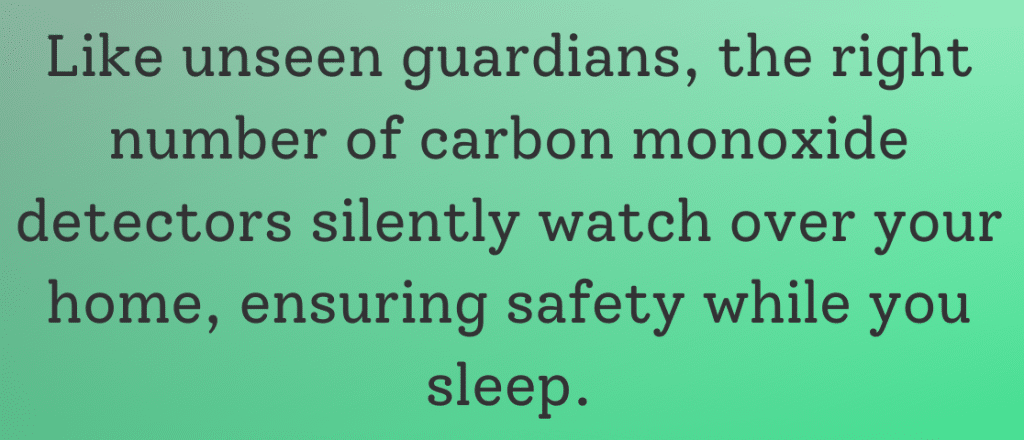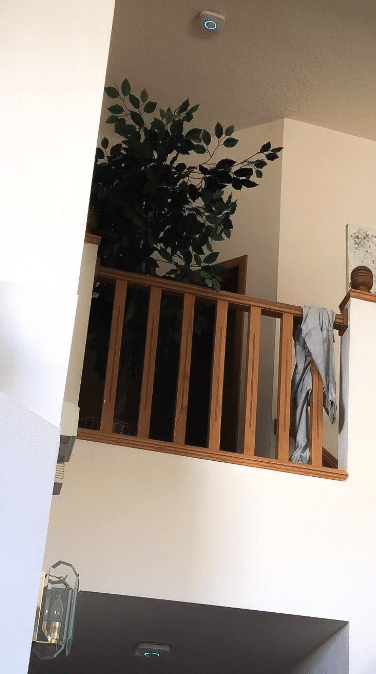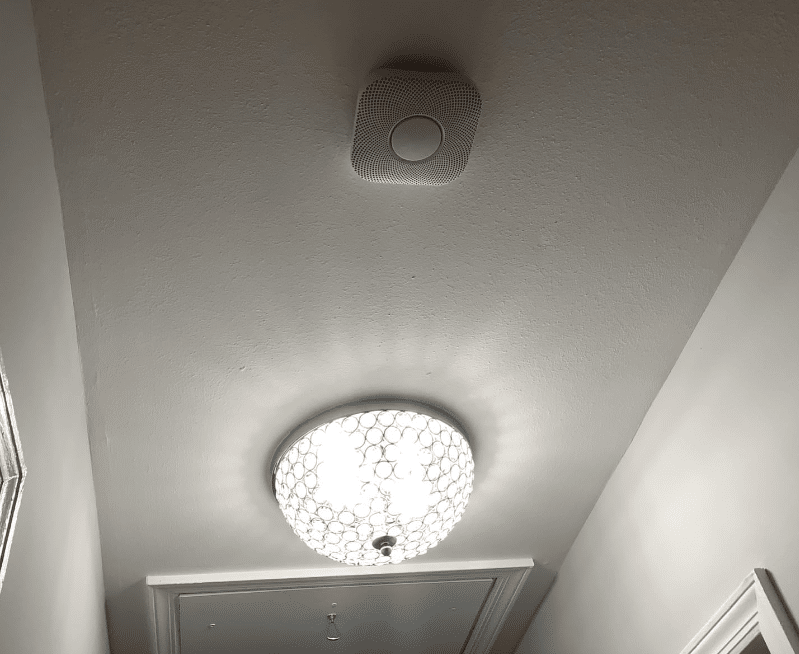How many carbon monoxide detectors do I really need in my home? It’s a life-saving question that is worth thinking and finding answers to now rather than later. Because ensuring your home is equipped with the right number of carbon monoxide detectors can mean the difference between safety and tragedy.

Let’s explore the essential guidelines and considerations that will help you secure your living space against this silent killer.
Key Takeaways
- Placement is crucial: Install carbon monoxide detectors on every level of your home, especially near sleeping areas.
- Maintenance is key: Regularly test and replace batteries to ensure detectors are always operational.
- Legal requirements: Check local laws to ensure compliance with safety regulations.
Contents
- 1 How Many Detectors Do You Need?
- 2 Carbon Monoxide Risks
- 3 Why Carbon Monoxide Detectors?
- 4 Proper Placement of Detectors
- 5 Maintenance and Testing
- 6 Advanced Tips and Common Mistakes
- 7 Preventing Carbon Monoxide Poisoning
- 8 Frequently Asked Questions
- 8.1 1. How do I know if my carbon monoxide detector is working?
- 8.2 2. Can carbon monoxide detectors detect natural gas leaks?
- 8.3 3. What should I do if my carbon monoxide detector goes off?
- 8.4 4. Where should carbon monoxide detectors NOT be installed?
- 8.5 5. How many carbon monoxide detectors do I need for a small apartment?
- 8.6 6. Are plug-in carbon monoxide detectors effective?
- 8.7 7. How often should I test my carbon monoxide detector?
- 8.8 More FAQS
- 9 Conclusion
How Many Detectors Do You Need?

The number of carbon monoxide detectors needed can depend on several factors such as the size and layout of your home, the number of levels, and the presence of gas appliances.
General Guidelines
- Levels of the home: At least one detector on each floor including the basement and attic if used.
- Sleeping areas: Additional detectors near or in bedrooms so the alarm can wake you if CO levels rise during the night. Common areas outside the bedroom like the lounge area is also commended.
- In or near attached garages since cars produce carbon monoxide, which can seep into the house or a generator house if not detached from your main house. The detector should be near the entrance from the garage into the house.
- Close to gas-powered appliances, such as stoves, water heaters, or fireplaces.
- Legal requirements: Some areas have specific laws regarding the number and placement of detectors.
Learn more about the legal requirements from the NFPA Guidelines for Carbon Monoxide Alarms.
Table: Number of Carbon Monoxide Detectors Based on Home Size
| Home Feature | Minimum Number of CO Detectors Needed |
|---|---|
| One-story home with no garage | 1 (near bedrooms) |
| Two-story home with no garage | 2 (one per floor) |
| Home with a basement | 3 (one per floor and in basement) |
| Home with attached garage | 3 (include one near garage) |
| Large home with multiple bedrooms | 1 per floor and near each bedroom |
Factors Influencing Detector Quantity
- Size of the home: Larger homes may need more detectors.
- Number of gas appliances: Each appliance is a potential source of CO.
- Age of appliances: Older appliances may pose a higher risk of CO emission.
| Factor | Importance |
|---|---|
| Home size | Larger homes require more detectors |
| Number of appliances | More appliances increase risk |
| Sleeping areas | Critical for nighttime safety |
Carbon Monoxide Risks
Carbon monoxide (CO) is a deadly gas that can be produced by any fuel-burning device. Preventing CO poisoning starts with understanding its sources, such as furnaces, stoves, and water heaters. Unfortunately, without a detector, CO is undetectable by human senses, which is why it’s essential to equip your home properly.
What is Carbon Monoxide?
- Invisible danger: CO is impossible to see, taste, or smell.
- Sources in the home: Common household appliances like gas stoves, heaters, and dryers can emit CO. Also included in this list are any fossil fuel burning engines such as cars and generators.
- Health risks: Exposure can lead to serious health issues, dizziness, headaches and even death.
Why Carbon Monoxide Detectors?
Installing CO detectors can be the single most important step you take to safeguard your family against carbon monoxide poisoning.
Types of Detectors
Carbon monoxide detectors vary in technology and design, each suited for different monitoring needs:
Electrochemical Sensor
- High sensitivity: Detects low levels of CO.
- Accurate: Provides precise readings.
Biomimetic Sensor
- Color change: Uses a gel that changes color when CO is present.
- Visual alert: Offers a clear indication of CO levels.
Metal Oxide Semiconductor
- Advanced technology: Utilizes a silica chip that reacts to CO by changing its electrical resistance.
- Durable: Effective for long-term monitoring.
How They Work
All these sensors trigger an alarm when dangerous levels of CO are detected, alerting you to potential danger. Regular testing and maintenance are crucial to ensure they function properly when you need them most.
Importance in Home Safety
- Early warning: Detectors provide crucial time to evacuate, potentially saving lives.
- Legal compliance: Many jurisdictions require CO detectors by law.
Proper Placement of Detectors
Choosing the right locations for carbon monoxide detectors is crucial for effective operation and early detection of this deadly gas.

Recommended Placement
- Near bedrooms: To ensure alarms can be heard at night.
- Away from fuel-burning appliances: To avoid false alarms and ensure proper detection.
- On every level: Including the basement and attic.
Placement Tips
- Height considerations: CO mixes with air, so detectors can be placed at any height.
- Avoiding false alarms: Keep detectors away from high humidity areas like bathrooms and kitchens.
Maintenance and Testing
Keeping your carbon monoxide detectors in tip-top shape is as crucial as having them in the first place. It’s all about ensuring they are ready to protect you when it matters most.
Regular Testing
- Weekly checks: Press the test button on your detector to ensure it’s working.
- Hear the beep: If it beeps, you’re good to go. If not, it might be time for a battery change or a checkup.
Battery Replacement
- Schedule changes: Replace batteries at least once a year, or as recommended by the manufacturer.
- Stay powered: For detectors plugged into outlets, ensure they have battery backups.
Lifespan of Detectors
Carbon monoxide detectors don’t last forever. They need to be replaced every 5 to 10 years depending on the brand and model. Some newer models will alert you when they’ve reached the end of their useful life. Regularly check the battery and test your detectors monthly to ensure they’re working properly
| Action | Frequency |
|---|---|
| Test your detector | Weekly |
| Change batteries | Annually or as needed |
| Replace detector | Every 5-10 years |
Pro tip: Check the manufacturer’s guidelines to know exactly when to replace your unit.
Advanced Tips and Common Mistakes
Enhancing your CO safety strategy involves more than just installation. Avoid common pitfalls and adopt advanced tips to ensure maximum protection.
Common Mistakes
- Improper placement: Near windows or doors can dilute CO concentration, leading to false negatives. Therefore, Avoid placing detectors:
- Directly in kitchens or bathrooms where humidity and steam can cause false alarms.
- Behind curtains or furniture, where airflow may be restricted.
- Near open windows or doors, as fresh air can disperse CO, preventing proper detection.
- Ignoring maintenance: Skipping regular tests can lead to non-functional alarms when you need them most. Testing your carbon monoxide detectors once a month is crucial to ensuring they’re functioning correctly. Also, be sure to change the batteries at least once a year, or sooner if the detector indicates a low battery.
Advanced Tips
- Integration with smart home systems: Connect your CO detectors with your smart home to receive alerts on your phone. There are countless ways you can achieve this with smart smoke and CO devices. See here for current prices and reviews.
- Regular professional inspections: Have a professional inspect your fuel-burning appliances annually.
Preventing Carbon Monoxide Poisoning
To further protect your home from carbon monoxide poisoning:
- Have your heating system inspected annually by a professional to ensure it’s functioning safely
- Never use outdoor grills or generators indoors, as they produce high levels of carbon monoxide
- Don’t leave your car running in an enclosed space, like a garage, even if the door is open
Frequently Asked Questions
Here are some of the most common questions about carbon monoxide detectors:
1. How do I know if my carbon monoxide detector is working?
Press the “test” button on your detector monthly to ensure it’s functioning properly. If you don’t hear a sound, check the battery or consider replacing the unit.
2. Can carbon monoxide detectors detect natural gas leaks?
No, carbon monoxide detectors only detect CO. For natural gas leaks, you will need a separate gas detector.
3. What should I do if my carbon monoxide detector goes off?
Immediately turn off any appliances that could be emitting CO, evacuate your home, and call emergency services.
4. Where should carbon monoxide detectors NOT be installed?
Avoid placing detectors in humid areas like bathrooms or too close to fuel-burning appliances to prevent false alarms.
5. How many carbon monoxide detectors do I need for a small apartment?
At least one detector should be installed near the sleeping area, and if your apartment has multiple levels, place one detector per floor.
6. Are plug-in carbon monoxide detectors effective?
Yes, plug-in detectors are effective, but it’s essential to choose one with a battery backup in case of a power outage.
7. How often should I test my carbon monoxide detector?
Test your carbon monoxide detector at least once a month and replace the batteries yearly.
More FAQS
How many carbon monoxide detectors should I have in my home?
- Install one on each level and near each sleeping area for optimal protection.
Where is the best place to install a carbon monoxide detector?
- Install them near bedrooms and living areas but away from high humidity and fuel-burning appliances.
What types of carbon monoxide detectors are there?
- There are mainly three types: electrochemical, biomimetic, and metal oxide semiconductor.
How do I know if my carbon monoxide detector is working?
- Test it weekly by pressing the test button. If it beeps, it’s working.
What should I do if my carbon monoxide detector goes off?
- Evacuate immediately and call emergency services from fresh air.
Can I install a carbon monoxide detector myself?
- Yes, follow the manufacturer’s instructions carefully or watch a helpful installation video.
When should I replace my carbon monoxide detector?
- Generally, every 5 to 10 years, depending on the manufacturer’s recommendations.
Conclusion
Installing the right number of carbon monoxide detectors in your home can significantly reduce the risk of carbon monoxide poisoning.
Make sure to install detectors on every level, near bedrooms, and close to fuel-burning appliances. Don’t forget to test your detectors regularly and replace them every few years. By following these guidelines, you’ll ensure that your family is well-protected from the dangers of carbon monoxide.
Stay safe, stay alert, and keep your detectors in check!